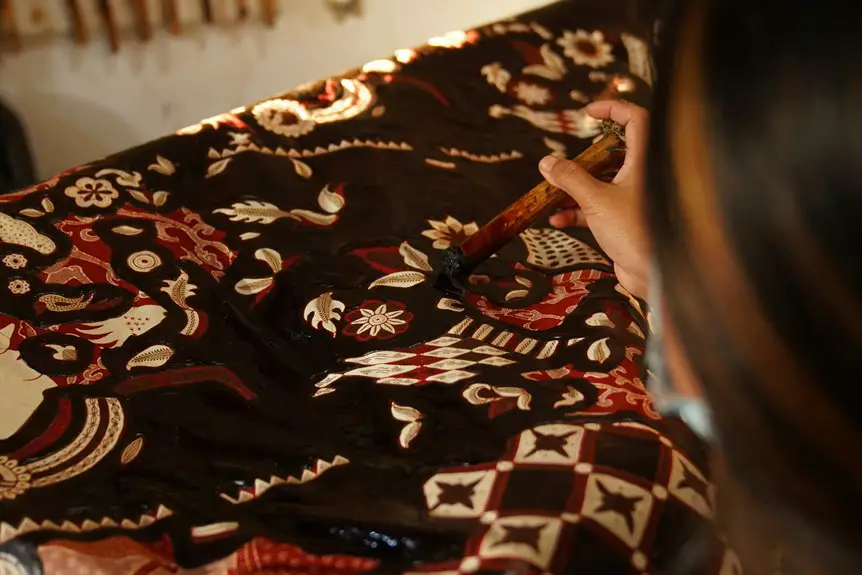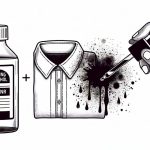To remove batik wax from fabric, start by softening the wax with a low-heat iron through parchment paper or absorbent paper towels. Press gently to lift the wax onto the paper, moving to a clean spot as needed. Next, apply a mild solvent like rubbing alcohol on a hidden area to test, then dab the wax residue carefully. Finally, wash the fabric with warm water and mild detergent, air-drying to avoid setting stains. For delicate fabrics or tougher stains, there’s more to discover.
Table of Contents
Key Takeaways
- Use a warm iron and absorbent paper towels to gently melt and lift batik wax from the fabric without overheating.
- Apply a suitable solvent like rubbing alcohol or acetone on a hidden area first, then dab on wax stains to dissolve residue.
- Rinse the fabric under cold water after solvent treatment and apply mild detergent to lift remaining wax before washing.
- Wash fabric according to care instructions using the warmest safe water, then air-dry to prevent wax from setting.
- For delicate fabrics, test all methods on a small hidden area and use lower heat settings to avoid damage.
Understanding Batik Wax and Its Effects on Fabric
Batik wax is a key component in traditional fabric dyeing, and it creates unique patterns by resisting dye on certain areas. When you apply the wax, it forms a barrier that prevents the dye from penetrating the fabric, resulting in those beautiful, intricate designs.
However, once the dyeing process is complete, the wax remains embedded in the fabric, often leaving a stiff or waxy residue. This residue can affect the fabric’s texture and flexibility, making it less comfortable to wear or use.
Understanding the nature of batik wax helps you realize why removing it is essential for restoring the fabric’s softness and appearance. Since the wax is hydrophobic and heat-sensitive, you’ll need specific techniques to melt and extract it without damaging the fabric.
Preparing Your Workspace and Materials
Before you start removing the wax, clear and clean your workspace to avoid any mess.
Gather all the essential tools like an iron, paper towels, and cleaning agents to have everything within reach.
Don’t forget to protect the surrounding surfaces to prevent accidental damage during the process.
Clear and Clean Area
Start by clearing a large, flat workspace where you can lay out the fabric and your cleaning materials without interruptions.
Make sure the surface is clean and dry to avoid transferring dirt or moisture onto the fabric.
Remove any clutter, dust, or debris that could interfere with the wax removal process.
Good lighting is essential, so position your workspace near a window or use a bright lamp to clearly see the wax stains.
Protect your work surface with old newspapers, a plastic sheet, or a washable cloth to catch any wax drips or cleaning residues.
This setup will help you work efficiently and prevent additional messes, ensuring the fabric stays clean throughout the wax removal process.
Gather Essential Tools
Once your workspace is set up and free of distractions, gather the tools you’ll need to remove the wax effectively.
You’ll want a clean, flat surface to work on. Grab a few paper towels or old cloths to absorb the melted wax. Have a dull knife or plastic scraper handy to gently lift off excess wax without damaging the fabric.
Prepare some plain brown paper bags or clean sheets of parchment paper for the wax removal process. Keep an iron nearby with adjustable temperature settings, as you’ll use it to heat the wax.
Finally, have a bottle of rubbing alcohol or a gentle stain remover ready to tackle any leftover residue. Having these essentials within reach will make your wax removal smoother and more efficient.
Protect Surrounding Surfaces
Since wax can easily spread and stain nearby areas, you’ll want to protect your workspace thoroughly. Lay down old newspapers, plastic sheets, or a disposable tablecloth to catch any drips or flakes. Cover nearby furniture and floors to avoid accidental stains. Wearing old clothes or an apron protects your own clothing. Clear the area of anything valuable or delicate to prevent damage.
| Item to Protect | Recommended Material |
|---|---|
| Work surface | Plastic sheet or tablecloth |
| Floor | Newspapers or drop cloth |
| Nearby furniture | Old sheets or plastic wrap |
| Your clothing | Apron or old clothes |
| Tools and supplies | Tray or container |
Taking these precautions keeps your workspace clean and makes cleanup easier.
Using Heat to Soften Batik Wax
You’ll want to pick the right heat source to soften the batik wax without damaging your fabric.
Applying heat carefully, whether with an iron or a hairdryer, helps melt the wax for easier removal.
Always keep safety in mind to avoid burns or fabric scorch marks while working.
Choosing the Right Heat
Applying the right amount of heat is essential when softening batik wax on fabric. Too little heat won’t melt the wax, and too much can damage your fabric or set the stain permanently. You want just enough warmth to soften the wax so it’s easier to remove without harming the material.
Keep these tips in mind when choosing your heat source:
- Use a low to medium heat setting on irons or hair dryers
- Avoid direct flames or very high temperatures
- Test heat on a small fabric corner first
- Consider the fabric’s heat sensitivity (cotton vs. silk)
- Use a protective barrier like parchment paper between heat and fabric
This careful approach helps you soften wax effectively and safely.
Heat Application Techniques
Two effective heat application techniques can help you soften batik wax without damaging your fabric.
First, use an iron on a low to medium setting. Place a brown paper bag or several layers of paper towels over the waxed area, then gently press the iron. The heat melts the wax, which the paper absorbs. Move the iron continuously to avoid scorching.
Second, try a hairdryer set to high heat. Hold it a few inches away from the fabric, directing hot air onto the wax. This loosens the wax, making it easier to blot or scrape off carefully with a dull edge.
Both methods let you soften the wax efficiently, preparing your fabric for the next removal steps while preserving its quality.
Safety Tips for Heating
Although heat helps soften batik wax effectively, taking safety precautions is essential to prevent burns or fabric damage.
When using heat, you need to be cautious and deliberate in your approach. Here are some safety tips to keep in mind:
- Use a low to medium heat setting on your iron or heat source to avoid scorching the fabric.
- Always place a protective cloth or parchment paper between the heat source and fabric.
- Keep your hands and fingers away from the hot surface to prevent burns.
- Work in a well-ventilated area to avoid inhaling any fumes released by melting wax.
- Never leave the heat source unattended while it’s on.
Following these tips will help you remove wax safely and protect both yourself and your fabric.
Techniques for Removing Wax With Absorbent Materials
One effective way to remove batik wax from fabric involves using absorbent materials like paper towels or brown paper bags.
First, place the fabric on a flat surface and cover the wax-stained area with a paper towel or a piece of brown paper. Then, gently press a warm iron over the paper. The heat will melt the wax, which the paper will absorb.
Move the paper to a clean spot and repeat until no more wax transfers. Be careful not to overheat, as excessive heat can damage delicate fabrics.
This technique helps lift the bulk of the wax without harsh chemicals. Once the wax is mostly absorbed, you can proceed with further cleaning steps if necessary.
Using absorbent materials keeps the process simple and effective.
Applying Solvents to Dissolve Wax Residue
After you’ve removed the majority of the wax using absorbent materials, applying solvents can help dissolve any remaining residue.
You’ll want to choose the right solvent to avoid damaging your fabric. Here’s how to proceed:
- Test the solvent on a hidden area first to check for colorfastness.
- Use a cotton ball or soft cloth to gently dab the solvent onto the wax stain.
- Common solvents include rubbing alcohol, nail polish remover (acetone), or dry cleaning fluid.
- Avoid soaking the fabric; apply solvent sparingly to prevent spreading the wax.
- Let the solvent sit for a few minutes to break down the wax before blotting with a clean cloth.
This method targets leftover wax without harsh scrubbing, preserving your batik fabric’s intricate design.
Washing the Fabric After Wax Removal
Once the solvent has softened the wax residue, washing the fabric will help remove any lingering traces and restore its original appearance.
Start by rinsing the fabric under cold water to flush out dissolved wax and solvent remnants. Then, apply a mild detergent directly to the stained area and gently rub it in.
Begin by rinsing with cold water, then gently rub mild detergent on the stain to lift wax residue.
Wash the fabric according to its care label, using the warmest water safe for the material. Avoid using bleach or harsh chemicals at this stage, as they may damage the fabric.
After washing, inspect the fabric carefully; if wax stains persist, repeat the solvent and washing steps before drying.
Finally, air-dry the fabric to prevent any residual wax from setting permanently through heat exposure. This process guarantees your fabric looks clean and wax-free.
Tips for Treating Delicate or Colored Fabrics
When dealing with delicate or colored fabrics, you’ll need to take extra care to avoid damage or discoloration during wax removal.
Here are some tips to help you preserve your fabric’s beauty:
- Test any cleaning method on a small, hidden area first to check for colorfastness.
- Use a lower heat setting when ironing to melt wax gently without scorching.
- Opt for mild detergents free of bleach or harsh chemicals.
- Avoid rubbing the fabric too hard; instead, blot gently to lift wax residues.
- Consider using cold water for rinsing to prevent color bleeding.
Preventing Wax Stains During Future Batik Projects
Although removing batik wax can be done effectively, preventing stains from happening in the first place saves you time and effort.
To avoid wax stains during your batik projects, work on a protected surface covered with newspaper or a plastic sheet. Always use high-quality wax that melts at a lower temperature to minimize splattering.
When applying wax, use tools designed for precision, like tjanting pens or brushes, to control where the wax goes. Wear protective clothing or an apron to shield your fabric and skin.
Keep a scrap piece of fabric nearby to test wax temperature and flow before applying to your main piece. Finally, work slowly and patiently—rushing increases the risk of spills and stains you’ll have to remove later.
When to Seek Professional Fabric Cleaning Services
Even with careful precautions, wax stains can sometimes be stubborn or extensive, making removal at home challenging.
You should consider professional fabric cleaning services when:
- The wax has deeply penetrated delicate or expensive fabrics.
- You’ve tried home methods without success.
- The fabric’s care label advises against DIY cleaning.
- The stain covers a large area or multiple layers.
- You’re concerned about preserving intricate batik designs.
Professionals have specialized tools and solvents that can safely remove wax without damaging your fabric.
Plus, they can handle complex stains that DIY methods might worsen.
When in doubt, it’s better to trust the experts to protect your cherished batik pieces and guarantee they look their best for years to come.
Don’t hesitate to reach out to a cleaner if the stain feels overwhelming.
Frequently Asked Questions
Can Batik Wax Removal Damage Fabric Colors Permanently?
You might risk damaging fabric colors if you use harsh chemicals or excessive heat during wax removal. Always test a small area first, and handle the fabric gently to help preserve its vibrant colors and avoid permanent harm.
What Types of Wax Are Used in Batik Fabric Making?
You know what they say, “Don’t judge a book by its cover.” In batik, artisans mostly use beeswax and paraffin wax—each blending flexibility and durability to create those beautiful, intricate fabric designs you’ll admire.
How Long Does It Take for Batik Wax to Dry on Fabric?
It usually takes batik wax about 10 to 20 minutes to dry on fabric, depending on the wax type and room temperature. You’ll notice it hardens quickly, allowing you to continue the dyeing process without much delay.
Is Batik Wax Removal Safe for All Fabric Types?
About 70% of fabrics can handle batik wax removal safely, but you shouldn’t assume all do. You’ll want to test a small area first, especially with delicate or synthetic materials, to avoid damage or discoloration.
Can Leftover Wax Affect Fabric Texture After Removal?
Yes, leftover wax can change your fabric’s texture, making it stiff or sticky. You’ll want to remove it thoroughly to keep the fabric soft and flexible, ensuring it looks and feels just right after cleaning.
- Where to Buy Sherpa Suede Fabric - July 12, 2025
- How to Draw or Illustrate the Texture of Suede Fabric - July 12, 2025
- What Is Baseball Suede Leather Fabric? - July 12, 2025






